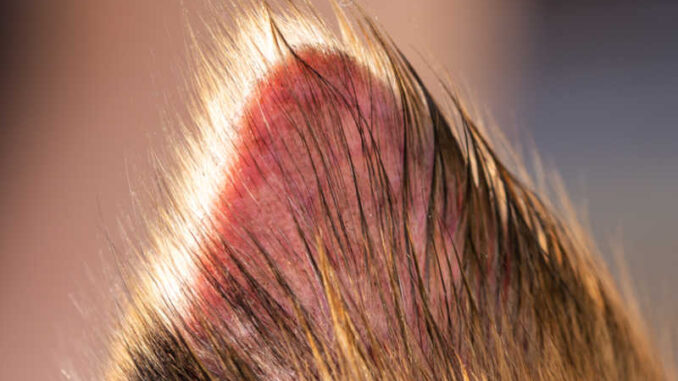
This article was updated on February 2nd, 2024

In this article, our experienced veterinarian Dr. Chyrle Bonk walks you through common causes of scabs on a dog’s ears, what they look like, and how to treat them.
Common causes of scabs on a dog’s ears
Scabs on a dog’s ears can appear differently depending on what is causing them. So, let’s take a look at the most common (with pictures) and what you can do about them.
1. Allergies causing excessive ear scratching
Dogs can develop allergies to things in their environment as well as to ingredients in their food. Both types of allergies can lead to skin that is dry, itchy, and inflamed. Dogs may also develop chronic ear infections with allergies. The combination of an ear infection and itchy skin can leave some dogs scratching or rubbing their ears, creating scabs on the ear flaps as well as under the flap near the ear canal. See picture below for an example:
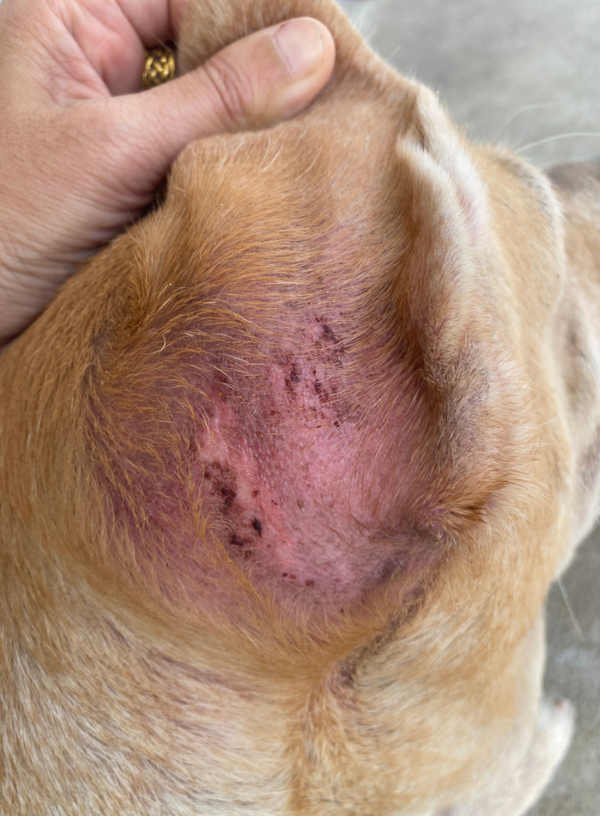

Signs that your dog has allergies: Dogs may also be itchy or have a rash in their ears or on other areas of their body, have a smelly discharge from their ears, or frequently shake their head.
How it is treated: Allergies are best treated by removing the allergen from a dog’s environment or diet, if possible. Since this can’t always happen, the next best treatment is antihistamines and anti-inflammatories, as well as treating any ear infections or scabs with topical antibiotics, antifungals, or anti-inflammatories. Learn more about allergies and skin issues in dogs.
2. Ear Infections
This was covered a bit in the allergies section, but not all ear infections stem from allergies. Ear infections may be common in pups with floppy or heavy ears. Think Basset Hounds, Golden Retrievers and Cocker Spaniels. Bacteria and yeast love to grow where it’s dark, warm, and moist, some things that these floppy ear flaps provide in the ear canal.
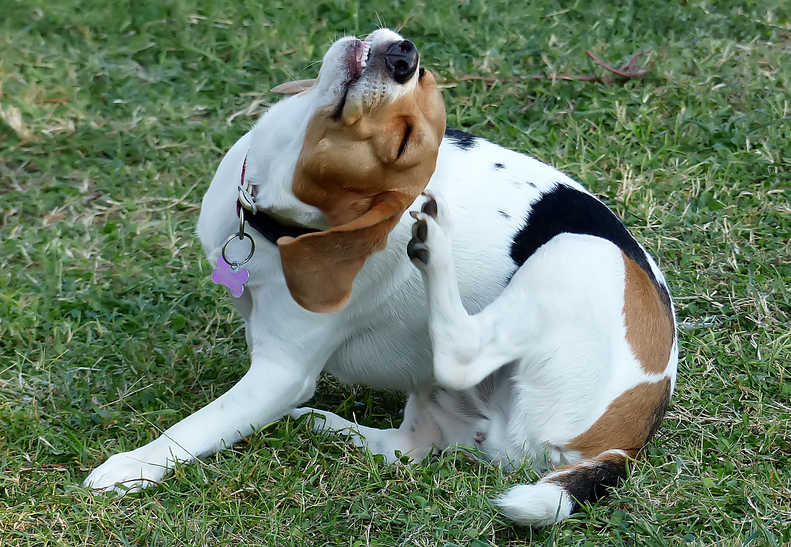
Signs that your dog has an ear infection: When bacteria or yeast reproduction goes into overdrive in these ideal conditions, they create an itchy, smelly mess in the ear that your dog wants nothing more than to scratch. It’s the scratching that creates scabs on their ear flaps or on the base of the ear. You may also notice a smelly discharge, head tilt, and lots of head shaking (even when their ears are clean).
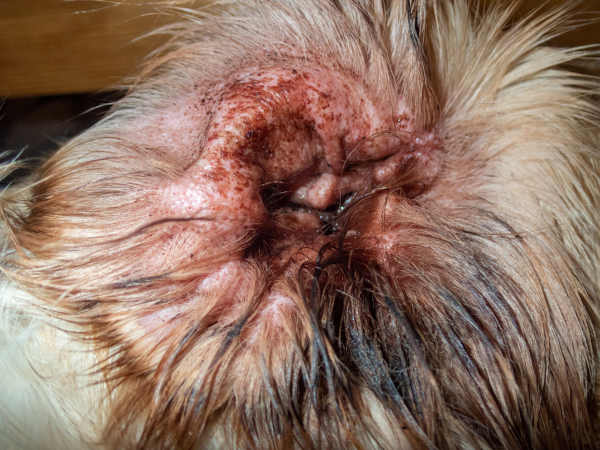
How it is treated: Veterinarians will treat ear infections by cleaning and the application of antibiotics or antifungal ointments. View pictures of common ear infections, with veterinarian advice, or home remedies for ear infections.
3. Parasites (Mites and Fleas)
Our poor pups are subject to many types of external parasites, including fleas, scabies (mange), and ear mites. All of these are capable of creating scabs on the ears.
Mites/Mange: Sarcoptic mange is a mite infestation that is contagious and acquired through contact with the mites in the environment or from another animal (e.g., fox, coyote, other dog). These infestations are very itchy, and excessive scabbing of the skin is common. The most common areas affected are the ear flaps (margin), elbows and hocks (ankles), as pictured below.
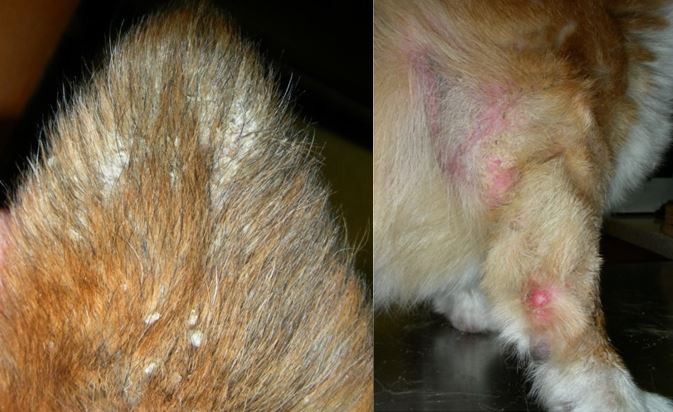
© Ian Brett Spiegel VMD, MHS, DACVD
Fleas: Fleas cause irritation to the skin when they bite. Some dogs are especially sensitive and even allergic to flea saliva, causing an itchy mess that can lead to scabs when they scratch, as shown on the images below:

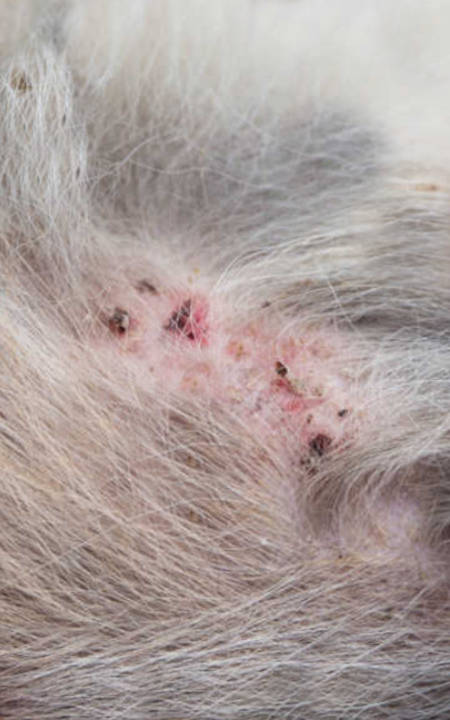
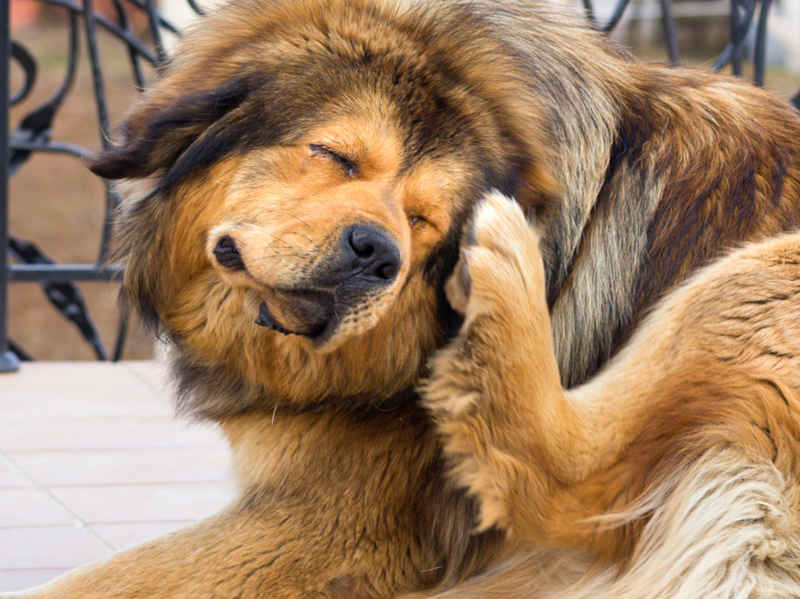
Mites and mange can also invade the skin, causing itching, skin inflammation, and hair loss. Ear mites like to target the ear canal, similar to an ear infection, and some types of mange prefer to live on the face. The ears may not be the only areas affected. Hair loss and scabs may occur anywhere on the body.
How it is treated: Your veterinarian will be able to diagnose external parasites with skin scraping. Most are treated with an antiparasiticide in the form of a bath, topical, or oral medication.
4. Injury
Injuries to ear flaps are common, especially if you have a puppy in your home. Ears can make the perfect chew toys, catch on things, or be affected by frost bite. With skin-breaking injuries come scabs. There may also be bleeding, swelling, redness, or bruising. Plus, injured ears are going to hurt. Dogs may shake their head, whine or cry when their ears are touched, or develop a secondary infection with a smelly, yellow discharge.
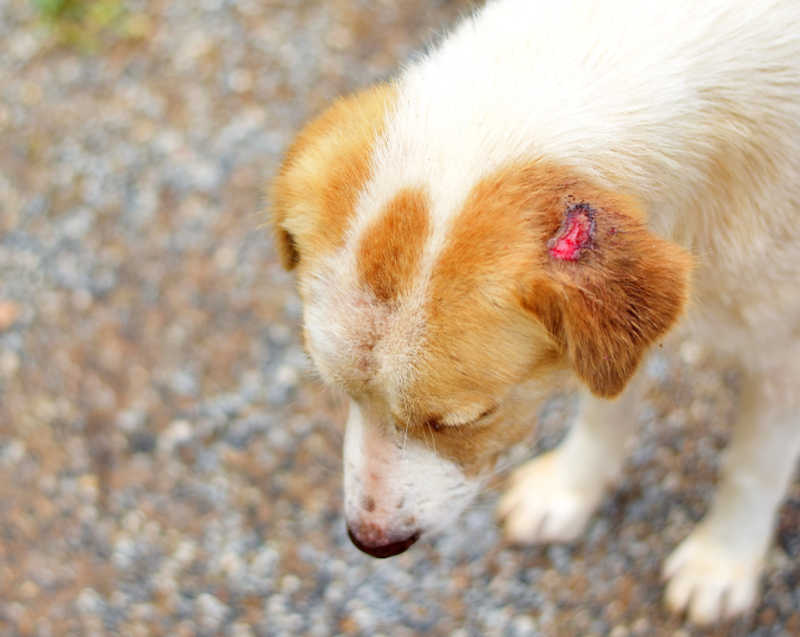
How it is treated: Gently cleaning an ear injury is the first step. From there, depending on the severity, you may need to have the wound stitched, wrapped, antibiotics, or other ointments to promote healing.
5. Seborrhea
Seborrhea is a disorder of the keratinization process where the outer layer of skin continuously renews itself. It can lead to scaly, greasy skin, often at the margins of the ears. Along with this excessive buildup of greasy scales, the skin can also become inflamed and infected, potentially leading to scabs on the ears and other areas of the body.
How it is treated: There is no cure for seborrhea, but it can be managed with shampoos and medications to help remove the scales and reduce inflammation.
6. Other causes of ear scabs
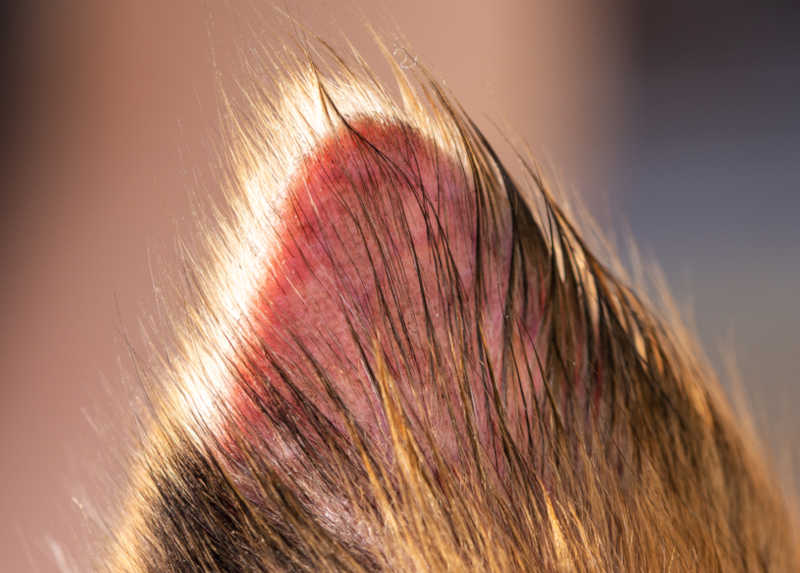
Some other causes of scabs on a dog’s ears include the autoimmune disease pemphigus foliaceus, which can cause hair loss, scabs, and other sores on the face, neck, and ears. Treatment requires immune suppression with medications.
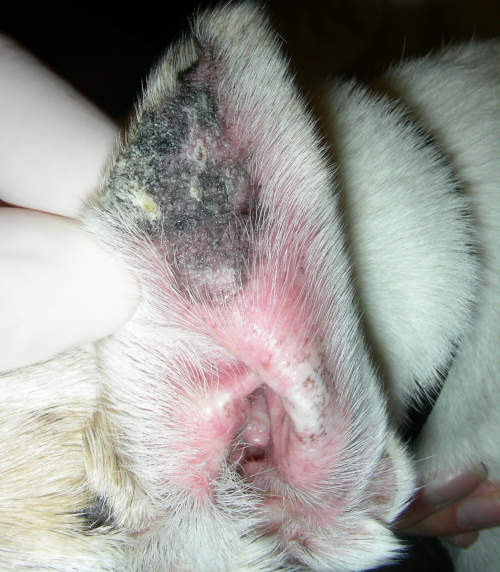
© Ian Brett Spiegel VMD, MHS, DACVD
Sunburn can also cause scabs on the ears, especially if the skin is damaged enough to blister. Sunburns happen more often in dogs with lighter-colored hair, and it may affect other lightly-haired parts of the body, including the nose and belly.
Lumps and bumps on the ear flap may also appear as scabs. Pictured below are benign warts on a dog’s ear flap:
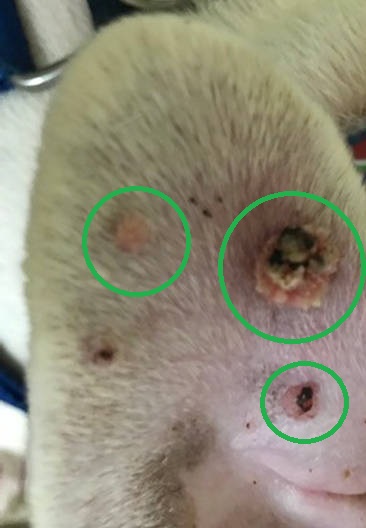
© Ian Brett Spiegel VMD, MHS, DACVD
Related post: Dog Ear Flap Issues: Cysts, Lumps & Bumps [With Pictures]
Most ear scabs do not heal on their own.
Most of the time, scabs on your dog’s ears aren’t going to go away on their own. They will need some form of treatment to clear them up. In order to get the right treatment, you’ll need the right diagnosis, which most often will require veterinary care.
At-home care (if your dog is not showing other signs of illness)
If your dog is experiencing any other issues, such as not eating, weight loss, extreme itchiness, a smelly discharge, or severe discomfort, see your veterinarian immediately. If they are only having mild discomfort without other signs, you may try some at-home treatments first, as discussed below.
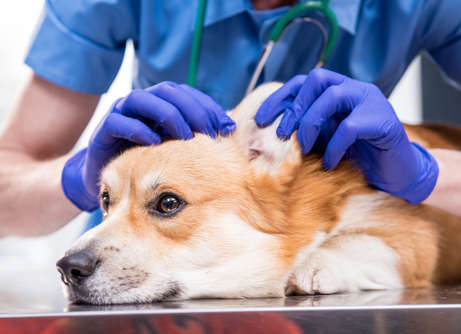
You’ll want to get a proper diagnosis before proceeding with any treatment; As with any other dog health issue, the treatment for scabs on a dog’s ears will be directly related to the cause.
– Make sure your pup is up to date on their flea treatment. Steer clear of over-the-counter products as most aren’t as effective or safe as those you get from your veterinarian. This will help to rid your pup of any external parasites that could be causing scabs on their ears.
– Check their ear canals for discharge. You can also clean the ears with a veterinary ear cleaner to help remove any excess gunk that could be causing itchiness. Of course, if the ear is red and inflamed, see your veterinarian.
– Gently clean any bite wounds or lacerations with mild soap and warm water. Apply a triple antibiotic ointment if the wound is minor. More severe wounds will need veterinary treatment.
Veterinary diagnosis and treatment
If your best at-home efforts aren’t showing some positive results within a day or two, or your pup is showing any signs, see your veterinarian. They may do some skin scrapings, ear swabs, or even bloodwork to determine the cause of your dog’s ear scabs. From there, they may prescribe antiparasiticides, antibiotics, anti-inflammatories, or a novel protein diet to help heal your dog’s ear scabs.
Related post: Dog Ear Flap Issues: Cysts, Lumps & Bumps [With Pictures]
Recommended Products
Virbac Epi-Otic Advanced Ear Cleaner is a go-to for veterinarians and dog parents for general cleaning of ears. Whether your pup is prone to ear infections or you just want to keep up on their ear health, regular or intermittent cleaning with Epi-Otic will help remove excessive wax buildup and debris as well as dry the ear canal to make it less hospitable to bacteria and yeast. See the listing on Amazon below:
- Non-irritating solution
Epi-Otic is used by filling the ear canal with the solution, massaging them at the base of the ear to loosen debris, and then wiping the ear canal clean with a dry paper towel on the end of your finger. Enlist the help of someone to hold your pup for easier application. Clean your dog’s ears as needed or as recommended by your vet.
Pet MD Ear Wipes are another great option for cleaning a dog’s ear flaps and outer ear canals. These ear wipes can help remove irritants, including allergens and dirt. They can also gently clean scabs and wounds to stop the itching and soothe irritated skin.
- Advanced Formulation Designed to Gently Clean, Deodorize and Dry Your Pets Ears
Ear wipes are extremely easy to use, and most dogs tolerate them very well. Just gently wipe the affected area with a clean wipe as needed or as recommended by your veterinarian.
Vetricyn Plus All Animal Skin Care Spray is a great all-around product to help with all of your dog’s minor wounds and skin irritation. Use Vetricyn to help soothe and heal scabs on the ears due to an injury or excessive scratching. Of course, you’ll want to treat the underlying cause of the itchiness as well, but this spray is a great option for starting the healing process.
- HEALING AID & SKIN REPAIR: Use a few times daily to flush dog cuts, abrasions, sores, and skin irritations
The Prognosis for Scabs on a Dog’s Ears
Most scabs on your dog’s ears will heal up once the underlying cause is treated. That includes getting allergies and ear infections under control, getting rid of external parasites and preventing future injuries. Most long-term or serious causes, such as an autoimmune disease or seborrhea, will need to be managed with medications.
FAQ
Why is my dog getting scabs on his ears?
Scabs on a dog’s ears may happen for a number of reasons, but most commonly follows some sort of skin irritation or inflammation that causes itchiness. A dog’s scratching is often what creates the scabs. However, it can also be the result of inflammation from an external parasite, injury, or autoimmune disease.
How do you help a dog’s ear scabs heal?
The best way to get a dog’s ear scabs to heal is to treat the cause. You’ll need to get rid of the source of the irritation to prevent future scabs from showing up. From there, you can use gentle cleansers and topical or oral medications to soothe and heal the skin.
What does it look like when a dog has ear mites?
Ear mites are extremely itchy. A dog may shake their head or scratch and rub their ears to try to get some relief. They may develop wounds or scabs at the base of their ears from scratching so hard. You may also notice a dark, crumbly discharge in the ear canal that resembles coffee grounds.
Should I pick ear scabs off my dog?
There is no need to pick the scabs off your dog’s ears. This can cause bleeding and even scarring. Instead, treat the cause of the scabs and then try to heal them with topical medications.
What kills dog ear mites instantly?
There are many medications suited for killing ear mites. Some are applied directly to the ear, others are applied to the skin or given orally. For the best efficacy and safety, only use products prescribed by your veterinarian.
How do I know if my dog has ear mites or an infection?
Ear mites and ear infections can appear very similar. They both cause itchiness and discharge. While there are some slight differences that you may note between ear mites and ear infections, the most definitive way is to have a veterinarian take an ear swab and examine it under a microscope. Read more: Dog yeast infection or ear mites?
Related posts about scabs in dogs:
 Scabs on Dogs [With Pictures]: Our Vets Explain What To Do - One common problem we often encounter as veterinarians is the presence of scabs (serous crusts) on a dog’s skin. Scabs… [...]
Scabs on Dogs [With Pictures]: Our Vets Explain What To Do - One common problem we often encounter as veterinarians is the presence of scabs (serous crusts) on a dog’s skin. Scabs… [...]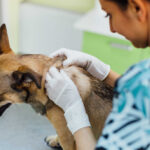 Crusty Scabs on Dogs: Top Causes and What To Do [Vet Advice] - Scabs serve as protective shields for injured skin, forming when skin is compromised, akin to a band-aid's role in human… [...]
Crusty Scabs on Dogs: Top Causes and What To Do [Vet Advice] - Scabs serve as protective shields for injured skin, forming when skin is compromised, akin to a band-aid's role in human… [...] Dog with Scabs & Losing Hair: Our Vet Explains What to Do - A dog losing hair in patches with scabs is a problem that many owners come to see us about at… [...]
Dog with Scabs & Losing Hair: Our Vet Explains What to Do - A dog losing hair in patches with scabs is a problem that many owners come to see us about at… [...] Black Scabs on Dog: Top Reasons & What to Do - The majority of black scabs will be insignificant and pose no threat to your dog. However, some black scabs could… [...]
Black Scabs on Dog: Top Reasons & What to Do - The majority of black scabs will be insignificant and pose no threat to your dog. However, some black scabs could… [...]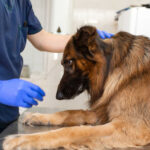 Scabs on Dog’s Head or Neck: Top Reasons [With Pictures] - Discovering scabs on your dog's body can be alarming, particularly when these scabs are on your dog's neck or head.… [...]
Scabs on Dog’s Head or Neck: Top Reasons [With Pictures] - Discovering scabs on your dog's body can be alarming, particularly when these scabs are on your dog's neck or head.… [...] Dog Nose Scabs and Lumps [Pictures & Vet Advice] - Dogs use their nose and sense of smell to explore the world around them. As most owners know, dogs will… [...]
Dog Nose Scabs and Lumps [Pictures & Vet Advice] - Dogs use their nose and sense of smell to explore the world around them. As most owners know, dogs will… [...]Disclaimer: This website's content is not a substitute for veterinary care. Always consult with your veterinarian for healthcare decisions. Read More.









Be the first to comment